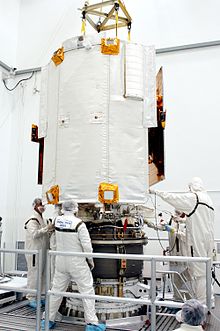This article needs additional citations for verification. (October 2015) |

In spacecraft design, the function of the thermal control system (TCS) is to keep all the spacecraft's component systems within acceptable temperature ranges during all mission phases. It must cope with the external environment, which can vary in a wide range as the spacecraft is exposed to the extreme coldness found in the shadows of deep space or to the intense heat found in the unfiltered direct sunlight of outer space. A TCS must also moderate the internal heat generated by the operation of the spacecraft it serves.
A TCS can eject heat passively through the simple and natural infrared radiation of the spacecraft itself, or actively through an externally mounted infrared radiation coil.
Thermal control is essential to guarantee the optimal performance and success of the mission because if a component is subjected to temperatures which are too high or too low, it could be damaged or its performance could be severely affected. Thermal control is also necessary to keep specific components (such as optical sensors, atomic clocks, etc.) within a specified temperature stability requirement, to ensure that they perform as efficiently as possible.